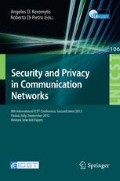Abstract
Exploiting static configuration of networks and hosts has always been a great advantage for design and launching of decisive attacks. Network reconnaissance of IP addresses and ports is prerequisite to many host and network attacks. At the same time, knowing IP addresses is required for service reachability in IP networks, which makes complete concealment of IP address for servers infeasible. In addition, changing IP addresses too frequently may cause serious ramifications including service interruptions, routing inflation, delays and security violations. In this paper, we present a novel approach that turns end-hosts into untraceable moving targets by transparently mutating their IP addresses in an intelligent and unpredictable fashion and without sacrificing network integrity, manageability or performance. The presented technique is called Random Host Mutation (RHM). In RHM, moving target hosts are assigned virtual IP addresses that change randomly and synchronously in a distributed fashion over time. In order to prevent disruption of active connections, the IP address mutation is managed by network appliances and totally transparent to end-host. RHM employs multi-level optimized mutation techniques that maximize uncertainty in adversary scanning by effectively using the whole available address range, while at the same time minimizing the size of routing tables, and reconfiguration updates. RHM can be transparently deployed on existing networks on end-hosts or network elements. Our analysis, implementation and evaluation show that RHM can effectively defend against stealthy scanning, many types of worm propagation and attacks that require reconnaissance for successful launching. We also show the performance bounds for moving target defense in a practical network setup.
Access this chapter
Tax calculation will be finalised at checkout
Purchases are for personal use only
Preview
Unable to display preview. Download preview PDF.
References
Lyon, G.F.: Nmap Network Scanning: The Official Nmap Project Guide to Network Discovery and Security Scanning. Insecure, USA (2009)
Laudicina, A.P.: Nessus - a powerful, free remote security scanner. Sys. Admin. 11(5) (2002)
Whyte, D., Kranakis, E., van Oorschot, P.C.: DNS-based Detection of Scanning Worms in an Enterprise Network. In: Proceedings of The 12th Annual Network and Distributed System Security Symposium (February 2005)
Bjørner, N., de Moura, L.: z310: Applications, enablers, challenges and directions. In: CFV 2009 (2009)
Antonatos, S., Akritidis, P., Markatos, E.P., Anagnostakis, K.G.: Defending against hitlist worms using network address space randomization. Comput. Netw. 51(12), 3471–3490 (2007)
Kewley, D., Fink, R., Lowry, J., Dean, M.: Dynamic approaches to thwart adversary intelligence gathering. In: DARPA Information Survivability Conference and Exposition, vol. 1, p. 0176 (2001)
Michalski, J.T.: Network security mechanisms utilising network address translation. International Journal of Critical Infrastructures 2(1), 10–49 (2006)
Atighetchi, M., Pal, P., Webber, F., Jones, C.: Adaptive use of network-centric mechanisms in cyber-defense. In: ISORC 2003, p. 183. IEEE Computer Society (2003)
Kewley, D., Fink, R., Lowry, J., Dean, M.: Dynamic approaches to thwart adversary intelligence gathering. In: Proceedings of DARPA Information Survivability Conference Exposition II, DISCEX 2001, vol. 1, pp. 176–185 (2001)
Jafarian, J.H., Al-Shaer, E., Duan, Q.: Openflow random host mutation: Transparent moving target defense using software defined networking. In: Proceedings of HotSDN workshop at SIGCOMM 2012, Helsinki, Finland (2012)
Yegneswaran, V., Alfeld, C.: Camouflaging honeynets. In: Proceedings of IEEE Global Internet Symposium (2007)
Cai, J.-Y., Yegneswaran, V., Alfeld, C., Barford, P.: An Attacker-Defender Game for Honeynets. In: Ngo, H.Q. (ed.) COCOON 2009. LNCS, vol. 5609, pp. 7–16. Springer, Heidelberg (2009)
Chakravarty, S.: A characterization of binary decision diagrams. IEEE Trans. Comput. 42(2), 129–137 (1993)
Al-Shaer, E.S., Hamed, H.H.: Discovery of policy anomalies in distributed firewalls. In: Twenty-Third Annual Joint Conference of the IEEE Computer and Communications Societies, INFOCOM 2004, vol. 4, pp. 2605–2616 (March 2004)
Zou, C.C., Towsley, D., Gong, W.: On the performance of internet worm scanning strategies. Elsevier Journal of Performance Evaluation 63, 700–723 (2003)
Zou, C.C., Towsley, D.: Routing Worm: A Fast, Selective attack worm based on IP address information. In: Workshop on Principles of Advanced and Distributed Simulation (PADS 2005), pp. 199–206 (2005)
Author information
Authors and Affiliations
Editor information
Editors and Affiliations
Rights and permissions
Copyright information
© 2013 ICST Institute for Computer Science, Social Informatics and Telecommunications Engineering
About this paper
Cite this paper
Al-Shaer, E., Duan, Q., Jafarian, J.H. (2013). Random Host Mutation for Moving Target Defense. In: Keromytis, A.D., Di Pietro, R. (eds) Security and Privacy in Communication Networks. SecureComm 2012. Lecture Notes of the Institute for Computer Sciences, Social Informatics and Telecommunications Engineering, vol 106. Springer, Berlin, Heidelberg. https://doi.org/10.1007/978-3-642-36883-7_19
Download citation
DOI: https://doi.org/10.1007/978-3-642-36883-7_19
Publisher Name: Springer, Berlin, Heidelberg
Print ISBN: 978-3-642-36882-0
Online ISBN: 978-3-642-36883-7
eBook Packages: Computer ScienceComputer Science (R0)

